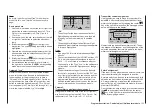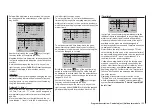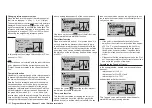
130 Program description - Dual Rate / Expo | Winged models
Dual Rate / Expo
Configurable control characteristics for aileron, elevator and rudder
This option is available as standard on
both transmitter types.
Use the selection keys of the left or right
four-way button to scroll to the »Dual
Rate / Expo« menu option in the Multi-function menu:
Servo adjustment
Stick mode.
Channel 1 curve
Switch display
Control adjust.
Dual Rate / Expo
Open this menu option with a tap on the center
SET
key of the right four-way button:
100%
100%
100%
Ail
Ele
Rud
DUAL
–––
–––
–––
SEL
The Dual-Rate-/Expo function permits flight-phase
dependent switching and control over the deflection
and characteristics of the aileron (Ail), elevator (Ele)
and rudder (Rud) (control functions 2 … 4) by way of
switches.
It is possible to set up an individual curve for control
function 1 (throttle / brake) using a maximum of six
separately programmable points. This is carried out
in the »Channel 1 curve« menu, which is available
on the
mc-16
HoTT and the
mc-20
HoTT trans-
mitter as standard; see the section starting on page
138.
Similar to control travel settings in the »Control ad-
just« menu, Dual Rate operates directly on the re-
spective control function, independent of whether it is
an individual servo or multiple servos connected via
complex mixer and coupling functions.
The control travel for each switch position can be set
to between 0 and 125 % of normal full travel.
Expo, on the other hand, enables finer-grained con-
trol of the model for values larger than 0 % around the
center position of the primary control function (ailer-
on, elevator and rudder), without forfeiting full move-
ment at the end-points of stick travel. For values less
than 0 %, the reverse is true: control increases around
the neutral position and diminishes towards the end-
points. The degree of “progression” can therefore be
set within a total range of -100 % to +100 %, where
0 % equates to the normal, linear control characteris-
tics.
Rotary-output servos, now generally commonplace,
offer another application. This is because the actual
control surface movement is not linear: as the rota-
tional angle of the output disc or lever increases, the
control surface rate of travel over the control linkage
continually decreases. This effect can be counter-
acted with Expo values greater than 0 % such that
rotational angle travel increases over-proportionally
with increasing stick throw.
The Expo setting also affects the relevant control
function directly, whether this controls a single servo
or multiple servos – via any number of mixer and cou-
pling functions.
For both Dual Rate and Expo functions, switch as-
signment can be set up in any way desired, which
therefore permits the triggering of multiple functions
using one and the same switch. This, in turn, offers
the opportunity to link the triggering of Dual Rate and
Expo functions to a single switch: this offers many
advantages – particularly for very high-speed models.
The graphic screen displays the curve characteristics
directly. After selecting the appropriate line, the dotted
vertical line will follow the movement of the respective
stick so a better evaluation of the transmitter-control-
travel dependent curve value can be made.
Flight phase-dependent Dual Rate and Expo set-
tings
If flight phases are set up in the »Phase settings«,
page 152, and »Phase assignment« menus, page
158, and each assigned a name, e. g. “Normal”, the
name in question will be displayed at the bottom left
of the display. Just actuate the respective switch to
switch between flight phases.
Basic procedure
1. Switch to the desired flight phase then use the
selection keys of the left or right four-way but-
ton to select the desired line: “Aileron”, “Elevator”
or “Rudder”.
2. Use the
selection keys of the left or right four-
way button to select the right column or the as-yet
invisible column for Expo values, see page 31.
3. Tap the center
SET
key of the right four-way but-
ton. The corresponding input field is shown high-
lighted.
4. Use the selection keys of the right four-way button
to set the desired value.
5. Tap the center
SET
key of the right four-way but-
ton to complete the entry.
6. A simultaneous tap on the
or
keys of
the right four-way button (CLEAR) will any setting
made back to its respective default value.
Dual Rate function
If a switchover between two variants is desired, as-
sign a switch in the column labeled with the
switch symbol (as described in the section “Physical
control, switch and control switch assignments” on
page 68):
mc
16 20
Summary of Contents for HoTT MC-16 Series
Page 1: ...Programming Manual mc 16 mc 20 HoTT 1 en mc 16 mc 20...
Page 27: ...27 For your notes...
Page 53: ...53 For your notes...
Page 61: ...61 For your notes...
Page 65: ...65 For your notes...
Page 71: ...71 For your notes...
Page 103: ...103 For your notes...
Page 107: ...107 For your notes...
Page 111: ...111 For your notes...
Page 155: ...155 For your notes...
Page 165: ...165 For your notes...
Page 201: ...201 For your notes...
Page 229: ...229 For your notes...
Page 231: ...231 For your notes...
Page 261: ...261 For your notes...
Page 265: ...265 For your notes...
Page 301: ...301 For your notes...
Page 327: ...327 For your notes...
Page 328: ...328 For your notes...
















































